
The Coleophoridae are a family of small moths, belonging to the huge superfamily Gelechioidea. Collectively known as case-bearers, casebearing moths or case moths, this family is represented on all continents, but the majority are found in temperate areas of the Northern Hemisphere. They are most common in the Palearctic, and rare in sub-Saharan Africa, South America, and Australia; consequently, they probably originated in northern Eurasia. They are relatively common in houses, they seek out moist areas to rest and procreate.

Olethreutes arcuella, the arched marble, is a colorful small moth species of the family Tortricidae.

Euplocamus anthracinalis is a species of tineoid moth. It belongs to the fungus moth family (Tineidae), and among these to the subfamily Euplocaminae.

Monopis obviella is a species of tineoid moth. It belongs to the fungus moth family (Tineidae), and therein to the nominate subfamily Tineinae. It is the type species of Blabophanes, today treated as a junior synonym of the genus Monopis. M. crocicapitella was only separated from the present species in 1859, and is still frequently confused with it even by rather recent sources.
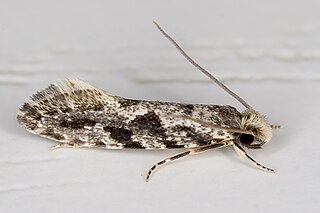
Nemapogon granella is a species of tineoid moth. It belongs to the fungus moth family (Tineidae), and therein to the subfamily Nemapogoninae. It is the type species of its genus Nemapogon, and via that also of the subfamily Nemapogoninae. It is also the type species of the proposed genera Brosis and Diaphthirusa, which are consequently junior objective synonyms of Nemapogon.

The brown-dotted clothes moth is a species of tineoid moth. It belongs to the fungus moth family (Tineidae), and therein to the nominate subfamily Tineinae. It is the type species of its genus Niditinea.

Batia lunaris, the lesser tawny crescent, is a species of gelechioid moth. It belongs to the subfamily Oecophorinae of the concealer moth family (Oecophoridae). It is the type species of the genus Batia, which is sometimes treated as monotypic. But this is not well warranted, as some other species usually placed there differ little from the Lesser Tawny Crescent.
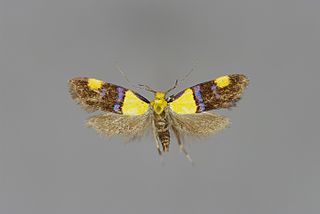
Oecophora bractella is a species of gelechioid moth. It belongs to the subfamily Oecophorinae of the concealer moth family (Oecophoridae). As the type species of its genus Oecophora, its affiliations and phylogeny determine the delimitation of that family and subfamily.

Esperia oliviella is a species of gelechioid moth.

Batia lambdella is a species of gelechioid moth. It belongs to the subfamily Oecophorinae of the concealer moth family (Oecophoridae). The genus Batia is sometimes treated as monotypic, but this seems spurious considering how similar B. lambdella is to the type species B. lunaris.

Borkhausenia minutella is a species of moth. Within its superfamily, it is placed within the subfamily Oecophorinae of the "concealer moth" family, Oecophoridae.

Alabonia geoffrella is a species of gelechioid moth. Here, it is placed within the subfamily Oecophorinae of the concealer moth family (Oecophoridae). Alternatively it has been placed in the Elachistidae or Depressariinae together with its presumed closest relatives.
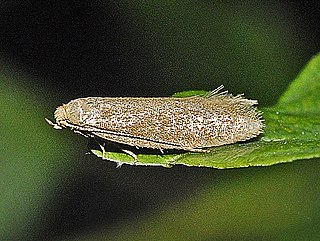
Pseudatemelia subochreella, the straw-coloured tubic, is a species of gelechioid moth.
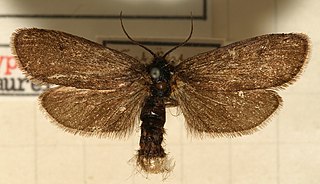
Lypusa is a genus of moths of the Lypusidae family, traditionally held to be a monotypic lineage of Tineoidea. However, it may actually belong to the same lineage of Gelechioidea as the Amphisbatinae.

Tinea trinotella is a species of tineoid moth. It belongs to the fungus moth family (Tineidae), and therein to the nominate subfamily Tineinae. It was once used as type species of a distinct genus Acedes, but this is synonymized today with Tinea, the type genus of Tineinae, Tineidae and the superfamily Tineoidea.
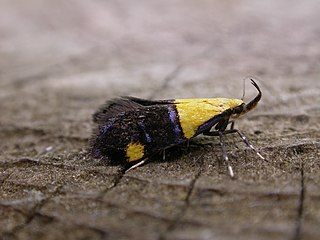
Oecophora is a genus of the concealer moth family (Oecophoridae). Among these, it belongs to subfamily Oecophorinae. It is the type genus of its subfamily and family. Thus, regardless of the uncertain phylogeny, systematics and taxonomy of its superfamily Gelechioidea, it and its closest relatives always have to be assigned to this family and subfamily as long as these are deemed valid.
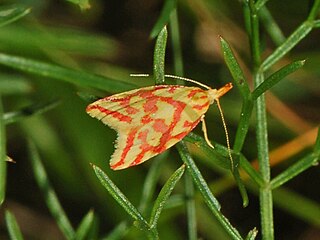
The Amphisbatinae was a small subfamily of moths in the superfamily Gelechioidea. Like their relatives therein, their exact relationships are not yet very well resolved. The present lineage is often included in the Depressariinae as a tribe Amphisbatini, though more often within the context of a "splitting" approach to Gelechioidea systematics and taxonomy, wherein the Depressariinae are elevated to full family rank and the Amphisbatinae are treated as a subfamily therein. An even more extremely split-up layout even treats the Amphisbatinae as full family Amphisbatidae. In the scheme used here, the Amphisbatinae are included in the Oecophoridae as a subfamily alongside the Depressariinae.

Pseudatemelia is a genus of gelechioid moths.
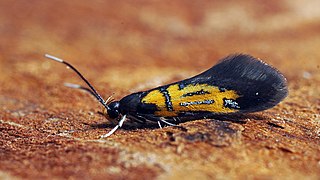
Schiffermuelleria is a genus of gelechioid moths. It is placed in the subfamily Oecophorinae of family Oecophoridae. The genus is treated as monotypic, with the single species Schiffermuelleria schaefferella placed here. As such, its distinctness from the closely related genus Borkhausenia – where S. schaefferella was often placed in the past – is open to debate.
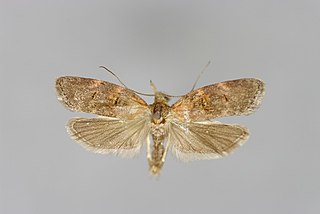
Anchinia is a genus of gelechioid moths.





















